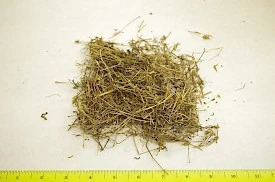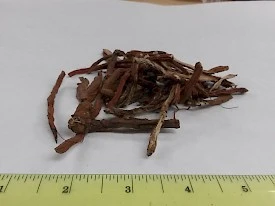Commonly Used Chinese Herbal Medicine for Lupus - Lab Analysis
Lupus, or systemic lupus erythematosus (SLE), is estimated to be experienced in various forms by 1.5 million people in the US about 3.5 million people elsewhere in the world. Far more common in women than men and the condition more commonly affects African Americans and Asians. It is an autoimmune condition where the body is triggered by poorly understood mechanisms to attack its own healthy body tissue. The disease can affect the physical organs and brain, as well as the skin and joints.
For some lupus symptoms will come and go with varying rates of intensity and duration. The most common areas are the hands, wrists and fingers as well as the knees. Along with the tissue inflammation there are a host of other symptoms which will vary from person to person but may include fatigue, fever, mouth sores, hair loss and then functional and/or psychological brain issues, physical organ issues, and more. One symptom, a skin rash most often over the cheeks and nose, the "butterfly rash", appears in about 50% of patients with lupus.
Many patients with autoimmune conditions such as lupus, MS, rheumatoid, fibromyalgia, and more come to Chinese Medicine practitioners for help. And while these conditions can be difficult to treat, the diagnostic tools within Chinese Medicine are often able to treat the root imbalances inherent with these conditions rather than chasing after various symptoms which generally does not work well.
From a Chinese Medicine perspective, as with all conditions, proper treatment requires proper diagnosis in Chinese Medicine terms. Due to this there are no hard and fast rules with these systemic autoimmune conditions. Our lupus treatment page contains some of the possible underlying TCM diagnoses involved with lupus. Proper treatment would potentially include all facets of Chinese Medicine - acupuncture, herbal medicine, medical qi gong, tuina medical massage and more. In general terms, Chinese Medicine offers much to patients who suffer with autoimmune conditions.
The study I am exploring today is a lab analysis on a lupus rat model of a Chinese Herbal Medicine that is used in patients with lupus. The herbal formula analyzed in this study is lang chuang fang, which is generally comprised of 7 herbs, the 5 most important are:
 Bai Hua She She Cao - a very important herb in Chinese Medicine from the clear heat and resolve toxicity category, used to clear heat from infections and/or inflammatory processes in the body.
Bai Hua She She Cao - a very important herb in Chinese Medicine from the clear heat and resolve toxicity category, used to clear heat from infections and/or inflammatory processes in the body.- Zi Cao - from the cool the blood category, used to clear skin rashes as well as for constipation.
- Ban Zhi Lian - also in the clear heat and resolve toxicity category has similar functions as bai hua she she cao.
- Sheng Di Huang - also in the cool the blood category, used similarly to zi cao with more beneficial effects on the yin.
 Dan Shen - in the invigorate the blood category, used to break apart pain and stagnation particularly in the chest and abdomen (menstrual cramps, abdominal pain, chest pain). Also uses with irritability and/or anxiety form heat in Chinese Medicine terms.
Dan Shen - in the invigorate the blood category, used to break apart pain and stagnation particularly in the chest and abdomen (menstrual cramps, abdominal pain, chest pain). Also uses with irritability and/or anxiety form heat in Chinese Medicine terms.
This particular formula comes from the work of Professor Ye a kidney disease specialist in China. It along with appropriate per patient adjustements has been used with good results clinically around the world, but the functions of how it may help are poorly understood outside of Chinese Medicine theory and understood herbal dynamics. This study, then, with the ability to deeply analyze tissue in the rat model is an important step in deepening our understanding of the mechanisms through which this formula helps lupus.
In their lupus induced rat model the researchers in the Department of Pharmacy at Sun Yat-Sen University in Guanzhou China found the following:
- Inhibits the destructive effects of the immune system by decreasing the expression of CD134 in T lymphocytes and CD134L in B lymphocytes - CD134 is found raised in lupus patient ( 1 ).
- Interferes with immune signaling molecules (CD 4, CD 8, CD 19, CD 23, CD 40) which would aid the proper functioning of the immune system. These markers are involved and often in disarry in lupus patients ( 2 ).
- Down regulates RANTES levels which reduce autoantibody formation. Rantes levels are often raised in lupus patients and with kidney damage ( 3 ).
- Reduced lymphocytes markers in the spleen and thymus and alleviate renal-impairment.
- Decrease the c-reactive protein (sign of tissue damage) and anti-dsDNA autoantibody levels (raised in 70-98% of patients with lupus) ( 4 ).
In laymens terms the formula appears to alter the majority of the known markers involved with the inflammatory and organ function issues found in lupus patients.
While proper treatment requires properly tailored approaches to each patient, the deeper exploration of this herbal formula provided by this study gives us some insight to both the internal changes from the herbs that comprise Lang Chuang Fang but also the internal functions involved in decreasing the symptoms of lupus.
tag @yinyanghouse for questions/comments